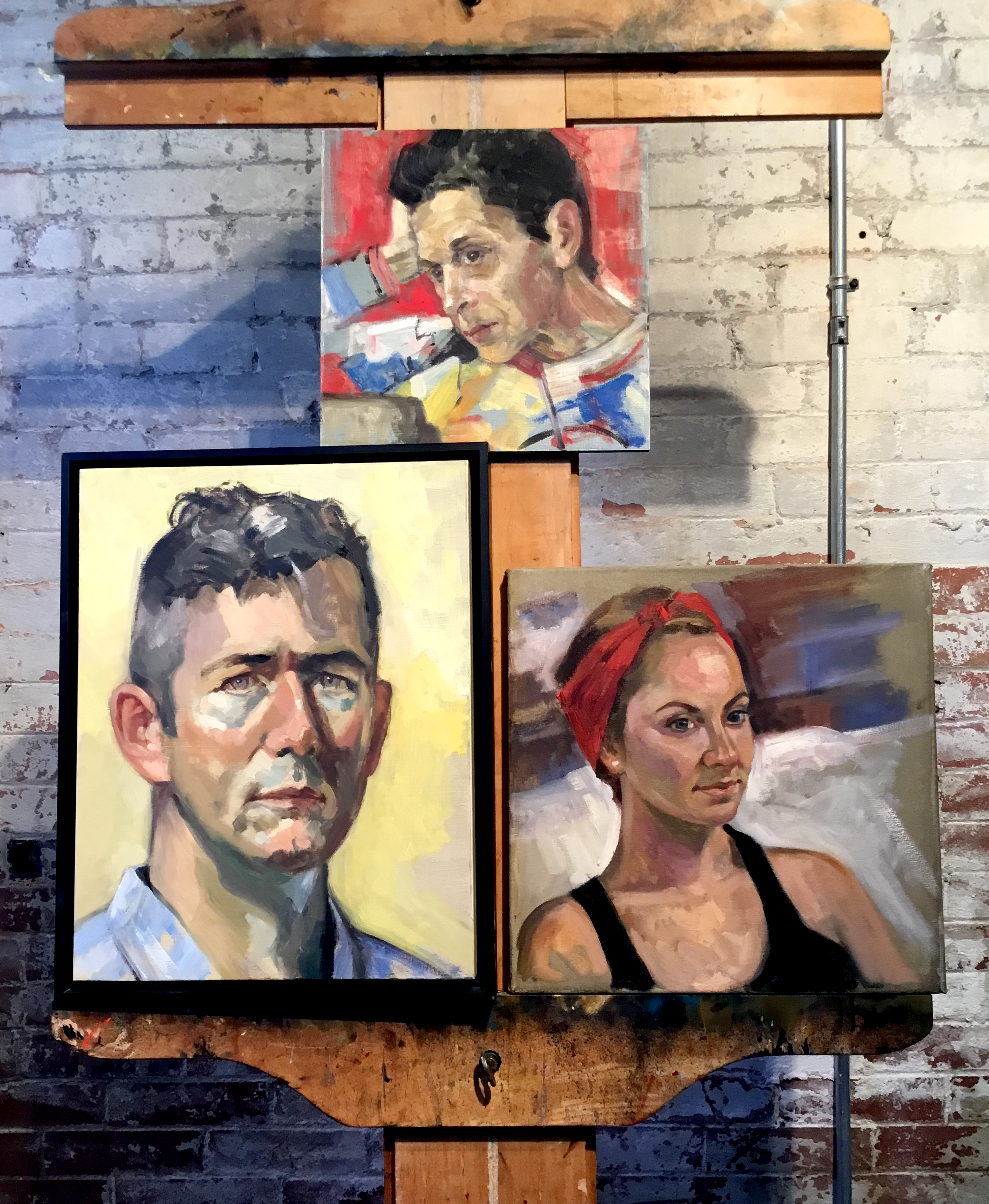
Here are some familiar faces from Wyndham's: Chris and Laura -- so helpful and friendly! (I still have to put the polka dots on Laura's headscarf), and regular customer Barb.

These studies were done in my Sunday sessions, and are all three-hour efforts. Oil on panel or on canvas. I enjoy the immediacy of working from life and the challenge of working quickly.
Surface Prep
To begin, I seal the panel with a couple of coats of GAC 100 and then apply 2-3 coats of Golden Gesso. Then I generally tone them with a middle value oil --sometimes yellow ochre and black, to give a nice greenish khaki hue.


Once that is completely dry (which takes a few days), I give it a light coat of shellac thinned with methyl hydrate. This is something I learned from taking a workshop with the wonderful American portrait artist Daniel Greene! It prevents the solvent used on the underpainting from lifting the colour on your toned surface, and also prevents the paint from sinking in.
I'm loving my Gamblin oil paints too! They are just the right consistency, not too oily or stiff.
Varnish
Recently I was faced with the issue of having to deliver a finished portrait for an unveiling at a hospital in downtown Toronto. I wanted the painting to have that finished look— deep, rich colours that pop and nice velvety blacks. Because oil colours tend to dry with an uneven finish- some matte, some more glossy, and because this effect is amplified in darker colours, I had a challenge with this particular piece and it's range of tonal values. (I don't usually varnish my work unless there is a specific reason to do so. I find that most of my paintings are comprised of medium to lighter values that don't show this unevenness nearly as much.)

Here's the finished piece. In this shot you can see the slight sheen of the varnish at the top right. I was happy with the overall effect and the way the varnish unified the piece and improved the darks.
I experimented with five different products / approaches:
1) Retouch varnish by Winsor & Newton. I was quite happy with the way the retouch varnish went on. Using a soft 1.5" varnishing brush, I applied just one coat, in steady even horizontal strokes. It dried nicely, and wasn’t too shiny. (The term retouch refers to the fact that this varnish brings back the 'wet look' which is nice on its own, but also allows the artist to see all the colours properly when going back and re-touching a painting with oil paint) Unlike most final varnishes, which should only be applied to thoroughly dried oil paintings, Retouch can be applied as soon as the painting is dry to the touch.
2) Gamvar Gloss by Gamblin. I applied this the same way. And, like Retouch, as long as the painting is dry to the touch (thickest parts have hardened up) you can use this varnish. When this one dried I found it a bit too shiny for my taste.
3) Gamvar Matte. This varnish might work well in some applications, but I found the matte finish too dull for my piece and it turned the blacks into greys.
4) A mixture of the Gloss and Matte Gamvar varnishes. I didn't get the right mix the first time, and it was still too matte. Customizing a mixture from two varnishes offers lots of options, but is a process of trial and error.
5) “Oiling out” technique. I created a thin, lean painting medium of one part Galkyd medium and one part Gamsol. Then painted it on with a varnishing brush and immediately wiped off excess with some cheesecloth. The result was quite good, and similar to the retouch varnish, but I think I prefer the retouch varnish.

This is a picture of my varnish test panel. It's hard to see the subtle differences in this shot, but as I was experimenting with different varnish mixtures to achieve varying levels of sheen. I made notes in the margins (it's always a good idea to keep a record of recipes!)


Here's Barb's portrait varnished with Gamvar Satin. On the left you can see the subtle relection on the surface, and on the right the face-on effect with the vivid colours and unified effect.
My Studio
Every Sunday we have a session with a portrait model in my studio. Artists come on a drop-in basis and we paint for three hours, from 10am until 1pm. It's my favorite day of the week! Another love for me is sculpture. I attend a weekly session with a life model, at the Guelph Pottery Centre, on Edinburgh Rd.
I also teach workshops at my studio twice yearly and hosts destination workshops to places such as Costa Rica and Italy. The next one is in Rajasthan, India, in March! (I’m taking 8 artists, and there are spaces available.)




More from this artist |
"My passion is painting people. I’ve always been fascinated by the way a face tells the story of a life. So much is to be seen in human expression—I want to know about this person, and what makes them unique. The way the light falls on the landscape of the face is of endless interest to me." |


1 comment
Melodie Wynne
How nice to see your surface prep documented for others to see; also your process for choosing the right varnish for a particular painting was interesting. A true professional at work.